Thai Airways Company or Thai Airways was the domestic flag carrier of Thailand. Its main base was the domestic terminal at Don Mueang International Airport. Its head office was located in Pom Prap Sattru Phai, Bangkok. In 1988, Thai Airways merged to become Thai Airways International.
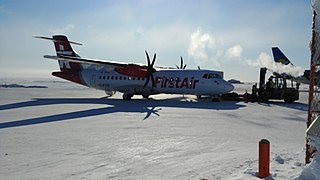
Bradley Air Services Limited, operating as First Air, was an airline headquartered in Kanata, a suburb of Ottawa, Ontario, Canada. It operated services to 34 communities in Nunavut, Nunavik, and the Northwest Territories. First Air has assisted in various humanitarian missions such as the 2010 Haiti earthquake, airlifting relief supplies and equipment. Its main base, which included a large hangar, cargo and maintenance facility, was located at Ottawa Macdonald–Cartier International Airport, with hubs at Iqaluit Airport, and Yellowknife Airport. On November 1, 2019, the airline consolidated operations with Canadian North.

The Hawker Siddeley HS 748 is a medium-sized turboprop airliner originally designed and initially produced by the British aircraft manufacturer Avro. It was the last aircraft to be developed by Avro prior to its absorption into Hawker Siddeley.
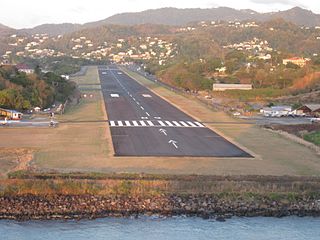
George F. L. Charles Airport is the smaller of the two airports in Saint Lucia, the other being Hewanorra International Airport. It is located 2 km (1.2 mi) north of Castries, the capital city. George F. L. Charles Airport is managed by the Saint Lucia Air and Seaports Authority (SLASPA). Its runway runs parallel to a pristine beach, Vigie Beach, which is a popular tourist attraction.
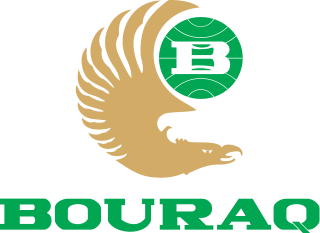
Bouraq Indonesia Airlines, branded sometimes as Bouraq Airlines or Bouraq, was an airline headquartered in Jakarta, Indonesia, which operated mostly domestic passenger flights out of its bases at Soekarno-Hatta International Airport and Sultan Aji Muhammad Sulaiman Airport.

Eastern Provincial Airways (EPA) was an airline that operated in Atlantic and eastern Canada. At its peak, the carrier operated jet service with Boeing 737-200 aircraft connecting many communities that today only have scheduled passenger flights provided by 18-seat commuter turboprop aircraft. The airline traces its history from Maritime Central Airways (MCA) from 1961. It merged with CP Air to form Canadian Pacific Air Lines in 1986.

Combi aircraft in commercial aviation are aircraft that can be used to carry either passengers as an airliner, or cargo as a freighter, and may have a partition in the aircraft cabin to allow both uses at the same time in a mixed passenger/freight combination. The name combi comes from the word combination. The concept originated in railroading with the combine car, a passenger car that contains a separate compartment for mail or baggage.
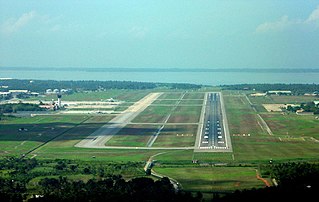
Bandaranaike International Airport (BIA) (Sinhala: බණ්ඩාරනායක ජාත්යන්තර ගුවන්තොටුපළ, romanized: Bandāranāyaka Jātyantara Guvantoṭupaḷa; Tamil: பண்டாரநாயக்க சர்வதேச விமான நிலையம், romanized: Paṇṭāranāyakka Carvatēca Vimāṉa Nilaiyam) (commonly known as Colombo International Airport, Colombo–Bandaranaike International Airport, and locally as Katunayake International Airport) (IATA: CMB, ICAO: VCBI) is the main international airport serving Sri Lanka. It is named after former Prime Minister S. W. R. D. Bandaranaike (1899–1959) and is in the suburb of Negombo, 32.5 kilometres (20+1⁄4 miles) north of the nation's capital and commercial center, Colombo.
Ratmalana International Airport, is the secondary international airport serving the city of Colombo, the capital of Sri Lanka. It was the country's first international airport and was the only international airport in Sri Lanka until the inauguration of Bandaranaike International Airport, Katunayake, in 1967. The airport currently serves several domestic services and is home to several aviation training organisations. A relaxation of rules has recently seen the airport open for international corporate jet operations and charter flights. The airport is located 15 km south of Colombo City.
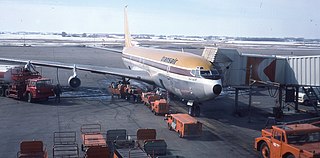
Transair was an airline based in Canada. It was purchased by Pacific Western Airlines in 1979. Transair's operational headquarters was located at the Winnipeg International Airport in Manitoba.
Jaffna International Airport, formerly known as Palaly Airport and Jaffna Airport, is an international airport serving northern Sri Lanka. It was also a military airbase known as Sri Lanka Air Force Palaly or SLAF Palaly. The airport is located in the town of Palaly near Kankesanthurai, 7 nautical miles north of the city of Jaffna. It is at an elevation of 10 m (34 ft) and has one runway designated 05/23 with an asphalt surface measuring 1,400 by 30 metres.

Air Illinois was a regional airline based in Carbondale, Illinois.

Air Lanka Flight 512 was an Air Lanka flight from London Gatwick Airport via Zurich and Dubai to Colombo and Malé, Maldives. On 3 May 1986, the Lockheed L-1011 Tristar operated by Air Lanka was on the ground in Colombo, about to fly on to Malé, when an explosion ripped the aircraft in two, destroying it. The flight carried mainly French, West German, British and Japanese tourists; 21 people were killed on the aircraft, including 3 British, 2 West German, 3 French, 2 Japanese, 2 Maldivian, and 1 Pakistani. 41 people were injured.
No. 2 "Heavy Transport" Squadron is a squadron of the Sri Lanka Air Force. It currently operates the C-130 Hercules and Antonov 32 from SLAF Katunayake.

The Sri Lanka Air Force Museum is the museum of the Sri Lanka Air Force, and its predecessor, the Royal Ceylon Air Force. Open to the public, the museum is at the SLAF Ratmalana and is maintained by the Sri Lanka Air Force.
Air BVI was an airline which operated and was based in the British Virgin Islands (BVI). Founded in 1971, by 1975 it had significantly added capacity to its fleet with the introduction of two Douglas DC-3 aircraft. Air BVI primarily flew between the Beef Island Airport (EIS) on Tortola and Luis Muñoz Marín International Airport in San Juan, Puerto Rico, providing connecting flights to and from major air carriers serving San Juan in order to enable tourists to visit the British Virgin Islands as well as providing transportation for local BVI residents and also served other destinations in the BVI such as Anegada and Virgin Gorda.
Trinidad and Tobago Air Services also known as the TTAS, was an Air Bridge service for Trinidad and Tobago. It was based at Piarco International Airport, Trinidad and Tobago.

The Air Ceylon Avro 748 4R-ACJ bombing occurred on 7 September 1978 when an Air Ceylon Hawker Siddeley HS 748 was destroyed in a fire following the explosion of a bomb in the aircraft while parked at Ratmalana Airport, Colombo, Sri Lanka. At the time, the pilot, first officer, and a ground crew worker were aboard; all three escaped unhurt.














